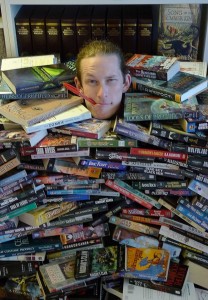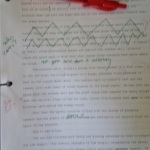I’ve mentioned Autocrit.com on panels at conventions. It’s a very useful tool that can assist any author when they’re polishing up their manuscript. Even when I’m about to send something off to an editor or getting ready to upload a submission, I usually run it through Autocrit first. It finds many common problems and does a decent first-pass analysis of my work. For example, it flagged the fact that I used “first” too many times in this paragraph.
Autocrit is a paid service, but it will analyze short passages for you. If you subscribe, you get more reports and can upload a full novel. Note that I am not an affiliate, so I get nothing for recommending this service. I liked it so much I picked up a lifetime subscription when they offered one, and I was actually driving to a convention when I pulled over and called it in. Yes, I like it that much.
I pasted an old H.G. Wells short story called “The Inexperienced Ghost” into the chute to run this analysis. The sections below are just a couple of the sections you get. Actually, you get pages and pages of information, depending on how in-depth you wish to delve into the work. You can run through each section and update the text within the website.
Most of the analysis that follows comes from just the “Summary” page.
The opening piece is general statistics. Of course it gives word counts, but it also shows number of uncommon words, number of sentences, and the average word length of the sentences.
Manuscript Statistics
General |
||||
|---|---|---|---|---|
| Number of Words | 4881 | |||
| Number of Uncommon Words | 1062 | |||
| Number of Sentences | 461 | |||
| Average Word Length of Sentences | 11 | |||
The next couple of sections show statistics on your speech tags and adverbs used with them. They also compare it with recent best-selling novels so you can see how you match up.
The sections that follow are very handy for me. It lets me know how many adverbs, passive voice, redundancies, cliches, and generic descriptions are in the work. These sections alone are worth their weight in gold, since I sometimes use clichés (like I just did) when I should have said it better and in my own words. Here we can see that Herbert could have cleaned up his prose a bit.
Adverbs |
||||
|---|---|---|---|---|
| Total Number of Adverbs | 61 | |||
| Top 3 | suddenly | 9 | ||
| really | 4 | |||
| slowly | 3 | |||
Passive Voice Indicators |
||||
|---|---|---|---|---|
| Total Number of Passive Voice Indicators | 175 | |||
| Top 3 | was | 64 | ||
| had | 47 | |||
| were | 16 | |||
Showing vs. Telling Indicators |
||||
|---|---|---|---|---|
| Total Number of Showing vs. Telling Indicators | 186 | |||
| Top 3 | it | 107 | ||
| knew | 39 | |||
| see | 18 | |||
Generic Descriptions |
||||
|---|---|---|---|---|
| Total Number of Generic Descriptions | 27 | |||
| Top 3 | very | 11 | ||
| suddenly | 9 | |||
| really | 4 | |||
Clichés |
||||
|---|---|---|---|---|
| Total Number of Clichés | 32 | |||
| Top 3 | the fact is | 3 | ||
| the thing | 3 | |||
| as if | 2 | |||
Now that I know Herbert should do a bit of rewriting. Most of the time I’m in the same boat. Arrgh…darn clichés.
Continuing on, the analysis shows how the pacing is for the first 50 paragraphs. That should be enough to give you a strong indication if your work has a bunch of dead spots. Herbert didn’t do too bad, in this case.
Finally, the Autocrit summary page will give me an indication of the word and phrase repetition. You’d be surprised how invisible that can be after you’ve been banging away on a keyboard for weeks, reading the same thing over and over.
There are more reports I can use to polish the manuscript. One I always check is the combination report under “Compare to Fiction”. The “personal words” highlighter finds the phrases and overused words that you tend to blindly sneak into the manuscript. It assists me when it comes to repeating the same thing over and over, especially since this sentence was flagged as having a redundant structure and a repetitive phrase.
Remember, you can try it out for free. You won’t get all of the reports, but it will give you a good idea of what you’ll get. Will it ever replace a good human editor? Nope. It does take care of the common junk that editors have to flag, and that gives them more time to find the real issues hidden in your book or story.
Website: http://www.AutoCrit.com



